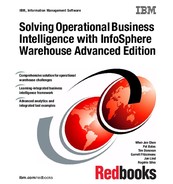
146 Solving Operational Business Intelligence with InfoSphere Warehouse Advanced Edition
the Cognos BI server. Figure 4-40 shows the Cognos Frameworks Manager
panel with our package.
Figure 4-40 Cognos Frameworks with our new package
In Cognos terms, we have now successfully published our package to the
Cognos BI server. But to make meaningful use of this package, we have to
create a Cognos report that displays the information within this package, and
thus within our cube service in a more user-friendly context. To achieve this goal,
we use the Report Studio of Cognos BI as follows:
1. Open a Microsoft Internet Explorer browser. Enter the URL http://<hostname
of the Cognos server>/ibmcognos, for example:
http://isw10g1/ibmcognos
The home window of Cognos BI will display as shown in Figure 4-41 on
page 147.
Browser note: Microsoft Internet Explorer is the only browser that
supports the full range of the Cognos tool set, in this case, Report Studio.

Chapter 4. Data modeling: End to end 147
Figure 4-41 Home panel of IBM Cognos BI
2. Before starting to create a report, we check our published package from the
browser. From the Welcome window, select My Home. This displays the view
that lists the packages loaded into the IBM Cognos BI server. See
Figure 4-42. Notice that currently there is nothing under our package area.
Figure 4-42 Packages loaded into the IBM Cognos BI Server

148 Solving Operational Business Intelligence with InfoSphere Warehouse Advanced Edition
3. Select Launch to reveal a pull-down menu as shown in Figure 4-43, then
select Report Studio.
Figure 4-43 Create a new report in IBM Cognos
4. This option opens a new panel that lists the packages you have published.
Select a package to open the Cognos Report Studio as shown in Figure 4-44.
In our case, we select CUSTOMER_PROFILE.
Figure 4-44 IBM Cognos BI Report Studio application
5. To create a new Cognos report, click Create New.
6. In the next panel, click the chart icon. In the following panel, click OK. A list of
the many possible report elements is presented. Click OK to select the default

Chapter 4. Data modeling: End to end 149
Chart - Column option. Figure 4-45 shows the panel displayed, with our
notes about the functions in this panel.
Figure 4-45 Create a new IBM Cognos report
7. Navigate into the CALENDAR_DATE dimension on the left side. Here you
can drag and drop the elements into the panes to create your chart. In our
example, we want year level as the X axis so we select the Year level under
the hierarchy, then drag and drop it onto the center graph pane.
Our Cube Service
notice fact and
dimensions
Our selected
column graph
Edit of
report
One of the three drag
and drop areas
Run
report

150 Solving Operational Business Intelligence with InfoSphere Warehouse Advanced Edition
8. Next, we drag and drop the measures NUM_OF_CST,
NUM_OF_CST_SURVD, and NUM_OF_SURVD_CST into the Series area,
which produces a panel as shown in Figure 4-46.
Figure 4-46 IBM Cognos report being created
9. Now we “run” this report to gather the data and produce a completed graph by
clicking the blue triangle play icon on the tool bar, shown at the top in
..................Content has been hidden....................
You can't read the all page of ebook, please click here login for view all page.
